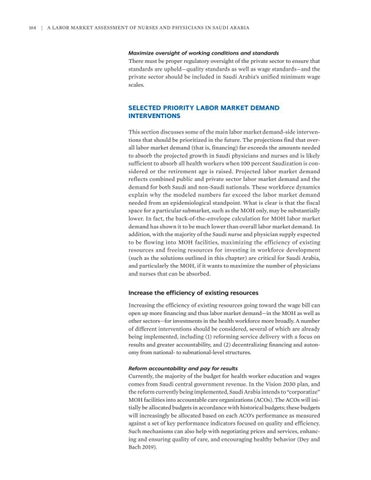164 | A Labor Market Assessment of Nurses and Physicians in Saudi Arabia
Maximize oversight of working conditions and standards
There must be proper regulatory oversight of the private sector to ensure that standards are upheld—quality standards as well as wage standards—and the private sector should be included in Saudi Arabia’s unified minimum wage scales.
SELECTED PRIORITY LABOR MARKET DEMAND INTERVENTIONS This section discusses some of the main labor market demand-side interventions that should be prioritized in the future. The projections find that overall labor market demand (that is, financing) far exceeds the amounts needed to absorb the projected growth in Saudi physicians and nurses and is likely sufficient to absorb all health workers when 100 percent Saudization is considered or the retirement age is raised. Projected labor market demand reflects combined public and private sector labor market demand and the demand for both Saudi and non-Saudi nationals. These workforce dynamics explain why the modeled numbers far exceed the labor market demand needed from an epidemiological standpoint. What is clear is that the fiscal space for a particular submarket, such as the MOH only, may be substantially lower. In fact, the back-of-the-envelope calculation for MOH labor market demand has shown it to be much lower than overall labor market demand. In addition, with the majority of the Saudi nurse and physician supply expected to be flowing into MOH facilities, maximizing the efficiency of existing resources and freeing resources for investing in workforce development (such as the solutions outlined in this chapter) are critical for Saudi Arabia, and particularly the MOH, if it wants to maximize the number of physicians and nurses that can be absorbed.
Increase the efficiency of existing resources Increasing the efficiency of existing resources going toward the wage bill can open up more financing and thus labor market demand—in the MOH as well as other sectors—for investments in the health workforce more broadly. A number of different interventions should be considered, several of which are already being implemented, including (1) reforming service delivery with a focus on results and greater accountability, and (2) decentralizing financing and autonomy from national- to subnational-level structures. Reform accountability and pay for results
Currently, the majority of the budget for health worker education and wages comes from Saudi central government revenue. In the Vision 2030 plan, and the reform currently being implemented, Saudi Arabia intends to “corporatize” MOH facilities into accountable care organizations (ACOs). The ACOs will initially be allocated budgets in accordance with historical budgets; these budgets will increasingly be allocated based on each ACO’s performance as measured against a set of key performance indicators focused on quality and efficiency. Such mechanisms can also help with negotiating prices and services, enhancing and ensuring quality of care, and encouraging healthy behavior (Dey and Bach 2019).

